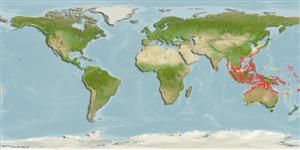>
Ovalentaria/misc (Various families in series Ovalentaria) >
Pomacentridae (Damselfishes) > Pomacentrinae
Etymology: Pomacentrus: Greek, poma, -atos = cover, operculum + Greek, kentron = sting (Ref. 45335).
Eponymy: Annie Montague Alexander (1867–1950) was an American philanthropist and fossil collector who established the fossil collection at the University of California Museum of Paleontology, Museum of Vertebrate Zoology and sponsored collecting expeditions. [...] (Ref. 128868), visit book page.
More on authors: Evermann & Seale.
Environment: milieu / climate zone / rango de profundidad / distribution range
Ecología
marino asociado a arrecife; no migratorio; rango de profundidad 5 - 60 m (Ref. 7247). Tropical
Western Pacific: Indo-Malayan Archipelago east to the Moluccas and Mentawai Islands, north to Taiwan and the Ryukyu Islands.
Tamaño / Peso / Age
Madurez: Lm ? range ? - ? cm
Max length : 9.0 cm TL macho / no sexado; (Ref. 9710)
Short description
Claves de identificación | Morfología | Morfometría
Espinas dorsales (total) : 13; Radios blandos dorsales (total) : 14 - 15; Espinas anales: 2; Radios blandos anales: 14 - 15.
Body shape (shape guide): short and / or deep; Cross section: compressed.
Adults occur in lagoon, inshore, and offshore reefs (Ref. 9710). Usually seen solitary, often swimming well above substrate (Ref. 48636). Feed on algae, barnacle nauplii, copepods, fish eggs, and small gastropods. Oviparous, distinct pairing during breeding (Ref. 205). Eggs are demersal and adhere to the substrate (Ref. 205). Males guard and aerate the eggs (Ref. 205).
Life cycle and mating behavior
Madurez | Reproducción | Puesta | Huevos | Fecundidad | Larva
Oviparous, distinct pairing during breeding (Ref. 205). Eggs are demersal and adhere to the substrate (Ref. 205). Males guard and aerate the eggs (Ref. 205).
Allen, G.R., 1991. Damselfishes of the world. Mergus Publishers, Melle, Germany. 271 p. (Ref. 7247)
IUCN Red List Status (Ref. 130435: Version 2025-1)
Threat to humans
Harmless
Human uses
Herramientas
Special reports
Download XML
Fuentes de Internet
Estimates based on models
Preferred temperature (Referencia
123201): 25.6 - 29, mean 28 °C (based on 634 cells).
Phylogenetic diversity index (Referencia
82804): PD
50 = 0.5000 [Uniqueness, from 0.5 = low to 2.0 = high].
Bayesian length-weight: a=0.02455 (0.01299 - 0.04638), b=3.00 (2.84 - 3.16), in cm total length, based on LWR estimates for this species & Genus-body shape (Ref.
93245).
Nivel trófico (Referencia
69278): 3.1 ±0.36 se; based on food items.
Resiliencia (Referencia
120179): Alto, población duplicada en un tiempo mínimo inferior a 15 meses (Preliminary K or Fecundity.).
Fishing Vulnerability (Ref.
59153): Low vulnerability (10 of 100).
🛈
Nutrients (Ref.
124155): Calcium = 120 [59, 184] mg/100g; Iron = 0.789 [0.472, 1.299] mg/100g; Protein = 18.3 [17.1, 19.4] %; Omega3 = 0.133 [0.079, 0.219] g/100g; Selenium = 27.6 [14.8, 51.1] μg/100g; VitaminA = 95.9 [27.5, 319.9] μg/100g; Zinc = 1.71 [1.15, 2.45] mg/100g (wet weight);
